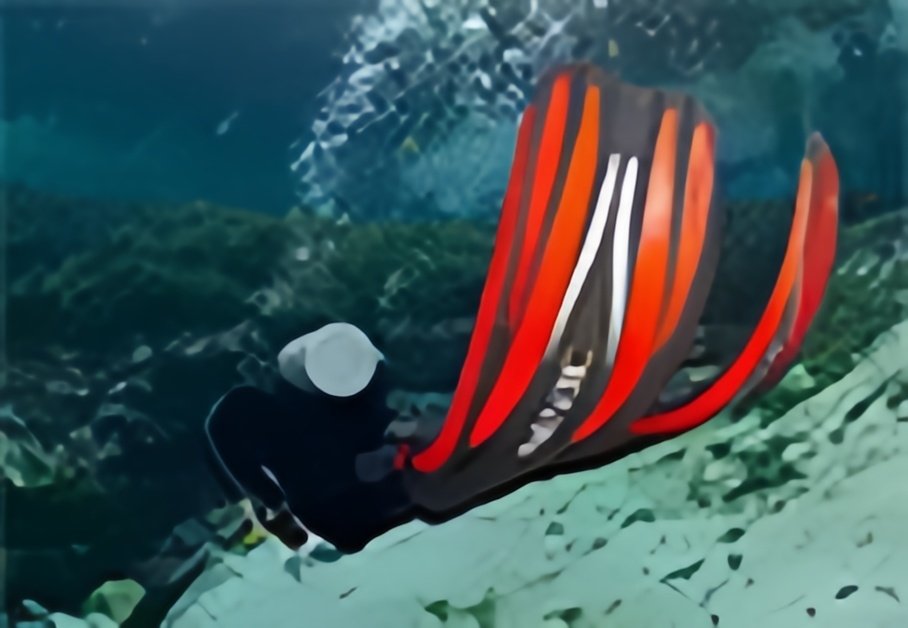Why Frog Kick?
The frog kick is a preferred swimming technique among divers for various reasons. Its unique motion provides several benefits that enhance the diving experience.
Benefits of Frog Kick
- Provides Forward Propulsion: The frog kick is highly efficient, propelling divers forward with minimal effort.
- Comfort and Balance: This kick offers a more comfortable and balanced swim, reducing strain on the body.
- Reduces Tension: When done correctly, it alleviates tension in the thighs, knees, and ankles.
- Prevents Sediment Disturbance: It doesn’t create a downward water flow, making it ideal for wreck and cave diving as it avoids stirring up sediment.
Step-by-Step Guide
Step One: Starting Position
Begin in a horizontal position in the water, with your knees bent at a 90° angle and fins parallel to the ground. Keep your knees and ankles in the same plane.
- Maintain Trim: Look forward slightly, gently arch your back, push your hips forward, and keep your arms in front of your body. This helps maintain a streamlined position known as Trim.
Step Two: Opening the Fins
Once you have achieved the starting position, separate your fins to the sides. This movement relies mainly on your ankles.
- Rotate Ankles: Rotate your fins outward using your ankles, keeping them parallel to the ground. The thin edge of the fins should glide gently on the water surface without significant resistance.
- Proper Leg Positioning: Your knees can be slightly apart, with a slight rotation of the hips. Avoid opening your legs and knees too wide to conserve energy and prevent accidental contact with coral or other structures.
Step Three: Forward Thrust
Forcefully bring your fins and feet together behind your body. Your ankles should gently rotate, your knees slightly extend, and your fins slightly descend.
- Slow and Powerful Kick: The kicking motion should be slow and powerful, using the strength of your legs and ankles to push water. Avoid rapid and unstable kicking, which generates little power and can cause discomfort.
- Maintain Core Position: Keep your core engaged, arch your back, push your hips forward, and extend your arms. This prevents your knees from dropping or your waist from bending during the kick.
Step Four: Glide (Most Comfortable Moment)
After the thrust, your legs extend, and your knees straighten slightly. With your feet and fins together in a streamlined position, you should glide through the water.
- Relax and Glide: Maintain the glide for a while to enjoy the forward movement. Avoid immediately returning to the starting position after step three, as this interrupts the glide and reduces speed.
- Return Smoothly: Slowly bring your heels up, relax your ankles, and return to the starting position.
Mastering the Frog Kick for Divers
Once you have mastered these four steps, ensure that each movement is smooth, slow, and relaxed. Practicing these steps will help you perfect the frog kick, making your underwater experience more enjoyable. With practice, you’ll find this technique superior to the flutter kick, enhancing your comfort and efficiency underwater.
FAQs
Why is the frog kick preferred by divers? The frog kick is efficient, reduces strain on the body, and doesn’t stir up sediment, making it ideal for wreck and cave diving.
How do I test if a diving mask fits properly? Place the mask gently against your face without using the strap and inhale through your nose. A properly fitting mask should create a seal and remain in place until you exhale.
What are the main benefits of using a snorkel for scuba diving? A snorkel reduces air consumption from the tank when at the surface, prevents water from entering the mouth in waves, and helps in swimming back to the boat or shore when low on air.
What should I consider when choosing fins for diving? Consider your body size, strength, and diving environment. Large, stiff fins provide speed but can lead to fatigue, while small, flexible fins offer less pushing power but are easier on the legs.
How does a buoyancy control device (BCD) enhance diving? A BCD allows divers to control their buoyancy underwater, enabling them to maintain neutral buoyancy, ascend, or descend at will.
What role does a dive computer play in scuba diving? A dive computer tracks dive time, depth, and nitrogen absorption, helping divers stay within safe limits and avoid decompression sickness.







